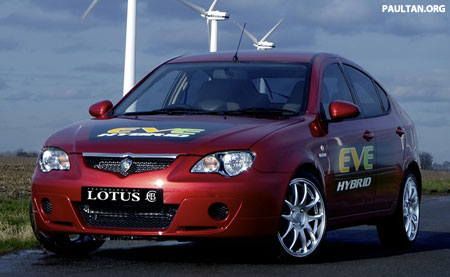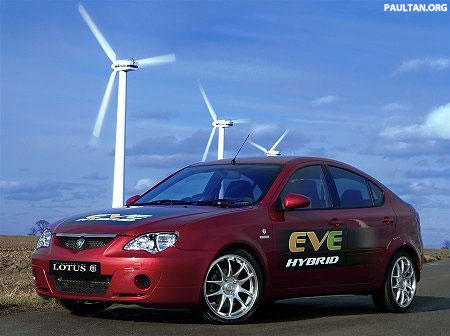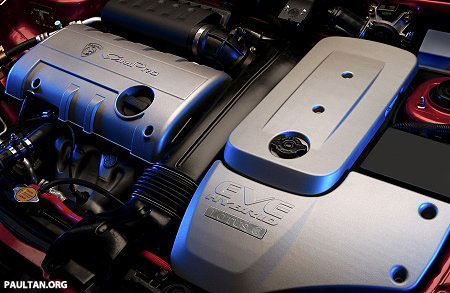anaksarawak
Official Member
- Joined
- Jan 20, 2007
- Messages
- 4,154
- Points
- 0
Found this from the net recently and find it interesting to share with all here-------------------------------------------------------------------------------------------------Proton and Lotus Engineering develop Proton GEN2 E
 Lotus Engineering will have this on display at the 2007 Geneva Motor Show, a Proton GEN2 equipped with Lotus Engineering’s EVE Hybrid technology. EVE, which stands for Efficient, Viable, Environmental, basically pairs Proton’s 1.6 liter Campro engine with a 30 kilowatt (40 horsepower) electric motor. The hybrid petrol-electric drivetrain drives the front wheels using a continuously variable transmission (CVT) gearbox.The hybrid system also has a start-stop system for the gasoline engine to be shut off when unneeded. The engine restarts automatically when the brake pedal is released. The electric motor is positioned between the engine and the gearbox, and supports regenerative braking to recharge its 144V battery located in the GEN2’s boot.The Proton GEN2 EVE Hybrid Concept has significantly lower emissions than it’s pure petrol sibling, with CO2 output only 134g/km from 172g/km. Average fuel economy rose from 6 liters per 100km to 4.6 liters per 100km. The combined output of the electric motor and the Campro 1.6 liter engine is 141hp, equivalent to a 1.8 to 2.0 liter engine in modern times, giving it a 0-100km/h time of 9 seconds and a top speed of 190km/h. Torque rises from the stock 148Nm at 4,000rpm to 233Nm at 1,500rpm.Perhaps we can see this Lotus EVE Hybrid technology being implemented in our local Proton cars soon, or perhaps we will be able to use that CVT transmission to replace the current 4-speed auto of which ratio’s do not match the Campro’s torque curve at all. A CVT would be wonderful for keeping the Campro’s revs within it’s powerband, allowing for a more comfortable and stressless drive.More photos after the jump, as well as Lotus Engineering’s full description of the Proton GEN2 EVE Hybrid car.
Lotus Engineering will have this on display at the 2007 Geneva Motor Show, a Proton GEN2 equipped with Lotus Engineering’s EVE Hybrid technology. EVE, which stands for Efficient, Viable, Environmental, basically pairs Proton’s 1.6 liter Campro engine with a 30 kilowatt (40 horsepower) electric motor. The hybrid petrol-electric drivetrain drives the front wheels using a continuously variable transmission (CVT) gearbox.The hybrid system also has a start-stop system for the gasoline engine to be shut off when unneeded. The engine restarts automatically when the brake pedal is released. The electric motor is positioned between the engine and the gearbox, and supports regenerative braking to recharge its 144V battery located in the GEN2’s boot.The Proton GEN2 EVE Hybrid Concept has significantly lower emissions than it’s pure petrol sibling, with CO2 output only 134g/km from 172g/km. Average fuel economy rose from 6 liters per 100km to 4.6 liters per 100km. The combined output of the electric motor and the Campro 1.6 liter engine is 141hp, equivalent to a 1.8 to 2.0 liter engine in modern times, giving it a 0-100km/h time of 9 seconds and a top speed of 190km/h. Torque rises from the stock 148Nm at 4,000rpm to 233Nm at 1,500rpm.Perhaps we can see this Lotus EVE Hybrid technology being implemented in our local Proton cars soon, or perhaps we will be able to use that CVT transmission to replace the current 4-speed auto of which ratio’s do not match the Campro’s torque curve at all. A CVT would be wonderful for keeping the Campro’s revs within it’s powerband, allowing for a more comfortable and stressless drive.More photos after the jump, as well as Lotus Engineering’s full description of the Proton GEN2 EVE Hybrid car.





 Technologies in the EVE Hybrid technology demonstratorA number of the technologies featured in the EVE Hybrid are production-ready, employing systems deliberately sourced from established tier one suppliers in order to demonstrate the availability of components, the minimisation of development costs and to maximise business case viability.The EVE Hybrid features three key technologies
Technologies in the EVE Hybrid technology demonstratorA number of the technologies featured in the EVE Hybrid are production-ready, employing systems deliberately sourced from established tier one suppliers in order to demonstrate the availability of components, the minimisation of development costs and to maximise business case viability.The EVE Hybrid features three key technologies 1) ‘Micro-hybrid’ stop-start system:A starter-alternator system was integrated that switches the engine off when the vehicle stops, during town driving for example. The engine restarts automatically when the brake pedal is released.As a result, noise, emissions and fuel consumption are reduced. The unit runs on the standard vehicle 12volt electrical system and combines both starter motor and alternator functionality. Fuel savings of 5% have been demonstrated with a 5% reduction in CO2 emissions.(2) Full parallel hybrid technology:A bespoke 30kW, 144V motor is packaged between the engine and transmission. It delivers electric drive or regenerative braking via an additional clutch linking the motor to the drivetrain. The motor provides the same start-stop functionality as the micro-hybrid with the additional benefit of electrical drive or drive assist, either boosting the drivetrain performance or providing economy and emissions benefits by operating as an electric vehicle. The motor is powered by a 144 volt battery located in the boot.Testing has confirmed simulation predictions of 28% fuel efficiency improvement and 22% CO2emissions reduction.(3) Continuously Variable Transmission (CVT)The CVT is a transmission in which the ratio between the input and output shaft can be varied continuously within a given range, providing an infinite number of possible ratios. The integration of a CVT gives benefits in fuel consumption and emissions control. In addition, its compact package assisted in the application of a hybrid electric drive and it provides smooth acceleration and low transmission noise.Performance benefits of EVE Hybrid technologies Extensive performance and drive cycle modelling of a production hybrid variant using the technologies on the EVE Hybrid indicate the following comparative vehicle performance figures
1) ‘Micro-hybrid’ stop-start system:A starter-alternator system was integrated that switches the engine off when the vehicle stops, during town driving for example. The engine restarts automatically when the brake pedal is released.As a result, noise, emissions and fuel consumption are reduced. The unit runs on the standard vehicle 12volt electrical system and combines both starter motor and alternator functionality. Fuel savings of 5% have been demonstrated with a 5% reduction in CO2 emissions.(2) Full parallel hybrid technology:A bespoke 30kW, 144V motor is packaged between the engine and transmission. It delivers electric drive or regenerative braking via an additional clutch linking the motor to the drivetrain. The motor provides the same start-stop functionality as the micro-hybrid with the additional benefit of electrical drive or drive assist, either boosting the drivetrain performance or providing economy and emissions benefits by operating as an electric vehicle. The motor is powered by a 144 volt battery located in the boot.Testing has confirmed simulation predictions of 28% fuel efficiency improvement and 22% CO2emissions reduction.(3) Continuously Variable Transmission (CVT)The CVT is a transmission in which the ratio between the input and output shaft can be varied continuously within a given range, providing an infinite number of possible ratios. The integration of a CVT gives benefits in fuel consumption and emissions control. In addition, its compact package assisted in the application of a hybrid electric drive and it provides smooth acceleration and low transmission noise.Performance benefits of EVE Hybrid technologies Extensive performance and drive cycle modelling of a production hybrid variant using the technologies on the EVE Hybrid indicate the following comparative vehicle performance figures 1) EVE Hybrid in micro-hybrid mode with start-stop system:MPG: 41 (5% increase from baseline)Max torque: 148Nm @ 4000rpmMax power: 82kW / 110hp @ 6000rpm0-62 mph (0-100kph): 12.6 secTop speed: 118mphCO2: 164g/km (5% reduction from baseline)(2) EVE Hybrid with full parallel hybrid configuration:MPG: 50.2 (28% increase from baseline)Max power: 105kW / 141hp @ 5500rpm0-62 mph: 9 secTop speed: 118mphCO2: 134g/km (22% reduction from baseline)(3) Continuously Variable Transmission configurationMPG (EU combined cycle): 41 (5% increase from baseline)Max torque: 148Nm @ 4000rpmMax power: 82kW / 110hp @ 6000rpm0-62 mph (0-100kph): 12.6 secTop speed: 118mphCO2 (combined cycle): 164g/km (5% reduction from baseline)Proton Gen.2 1.6litre 4-cyl gasoline (manual transmission) baseline for comparison:MPG (EU combined cycle): 39.2Max torque: 148Nm @ 4000rpmMax power: 82kW / 110hp @ 6000rpm0-62 mph (0-100kph): 12.6 secTop speed: 118mphCO2 (combined cycle): 172g/kmMax torque: 233Nm (limited to180Nm continuous) @ 1500rpm... type="text/ ... "> ... src="http://pagead2.googlesyndication.com/pagead/show_ads.js" type="text/ ... "> Technical details of EVE Hybrid technology demonstratorEngineVarious changes have been made to the Proton gasoline 1597cc CamPro engine. The main modification is the redesign of the front end accessory drive (FEAD). This was done to accommodate a Valeo ‘StARS’ starter/alternator, which drives the micro hybrid start-stop system. The redesigned FEAD also accommodates a Sanden hybrid Heating Ventilation and Air Conditioning (HVAC) compressor that operates by conventional belt drive and has an additional electrically driven capability which enables continued air conditioning operation when the engine is stopped. During the FEAD redesign the opportunity was also taken to replace the belt driven Power Assisted Steering (PAS) and water pumps with electric units to enable the investigation into the economy benefits of such units. To accommodate the additional hybrid functionalities the Engine Management System (EMS) was updated to a Siemens VDO torque-based unit and re-calibrated by Lotus Engineering.Motor/GeneratorDue to tight packaging constraints and to minimise any loss in overall vehicle performance, bespoke electric motor and power electronics were developed in conjunction with specialist suppliers ElektroMagnetix and Turbopower Systems. The motor/generator and power electronics are water-cooled and include an auxiliary power unit to support the vehicle’s 12volt systems. An additional clutch supplied by AP Racing is packaged inside the motor and connects the IC engine to the traction motor. This enables the engine to be switched off for electric drive only use.GearboxA Punch Continuously Variable Transmission (CVT) has replaced the conventional transmission and a modified bell housing accommodates the electric traction motor.Battery PackThe EVE Hybrid uses a Cobasys Series 1000, NiMH, 30kW 144V module that incorporates an integrated cooling system. This traction battery pack is securely mounted on the boot floor, displacing approx 47 litres of luggage space.Control SystemA sophisticated bespoke Lotus Engineering control system was developed to implement the energy management function by monitoring and controlling all sub-control systems including the engine management, motor/generator, transmission, HVAC, additional clutch, starter/alternator and battery pack.Brake SystemTo maintain the integrity of the braking circuit when the petrol engine is off, a Mes-Dea electric vacuum pump maintains the vacuum assist for the brakes.Steering SystemAn off-the-shelf TRW electro-hydraulic power assisted steering pump has been fitted, which allowed the retention of the existing steering column and hydraulic steering gear. This pump also provides hydraulic pressure for the additional clutch that engages the hybrid motor.InteriorThe instrument panel incorporates an additional LCD display developed by Lotus Engineering to show battery charge, power split between engine and motor, fuel economy and charge/discharge rate, and incorporates associated warning indicators where appropriate. Also fitted to the dash are new switches to select the car’s operating mode - micro hybrid, full hybrid or electric vehicle.
1) EVE Hybrid in micro-hybrid mode with start-stop system:MPG: 41 (5% increase from baseline)Max torque: 148Nm @ 4000rpmMax power: 82kW / 110hp @ 6000rpm0-62 mph (0-100kph): 12.6 secTop speed: 118mphCO2: 164g/km (5% reduction from baseline)(2) EVE Hybrid with full parallel hybrid configuration:MPG: 50.2 (28% increase from baseline)Max power: 105kW / 141hp @ 5500rpm0-62 mph: 9 secTop speed: 118mphCO2: 134g/km (22% reduction from baseline)(3) Continuously Variable Transmission configurationMPG (EU combined cycle): 41 (5% increase from baseline)Max torque: 148Nm @ 4000rpmMax power: 82kW / 110hp @ 6000rpm0-62 mph (0-100kph): 12.6 secTop speed: 118mphCO2 (combined cycle): 164g/km (5% reduction from baseline)Proton Gen.2 1.6litre 4-cyl gasoline (manual transmission) baseline for comparison:MPG (EU combined cycle): 39.2Max torque: 148Nm @ 4000rpmMax power: 82kW / 110hp @ 6000rpm0-62 mph (0-100kph): 12.6 secTop speed: 118mphCO2 (combined cycle): 172g/kmMax torque: 233Nm (limited to180Nm continuous) @ 1500rpm... type="text/ ... "> ... src="http://pagead2.googlesyndication.com/pagead/show_ads.js" type="text/ ... "> Technical details of EVE Hybrid technology demonstratorEngineVarious changes have been made to the Proton gasoline 1597cc CamPro engine. The main modification is the redesign of the front end accessory drive (FEAD). This was done to accommodate a Valeo ‘StARS’ starter/alternator, which drives the micro hybrid start-stop system. The redesigned FEAD also accommodates a Sanden hybrid Heating Ventilation and Air Conditioning (HVAC) compressor that operates by conventional belt drive and has an additional electrically driven capability which enables continued air conditioning operation when the engine is stopped. During the FEAD redesign the opportunity was also taken to replace the belt driven Power Assisted Steering (PAS) and water pumps with electric units to enable the investigation into the economy benefits of such units. To accommodate the additional hybrid functionalities the Engine Management System (EMS) was updated to a Siemens VDO torque-based unit and re-calibrated by Lotus Engineering.Motor/GeneratorDue to tight packaging constraints and to minimise any loss in overall vehicle performance, bespoke electric motor and power electronics were developed in conjunction with specialist suppliers ElektroMagnetix and Turbopower Systems. The motor/generator and power electronics are water-cooled and include an auxiliary power unit to support the vehicle’s 12volt systems. An additional clutch supplied by AP Racing is packaged inside the motor and connects the IC engine to the traction motor. This enables the engine to be switched off for electric drive only use.GearboxA Punch Continuously Variable Transmission (CVT) has replaced the conventional transmission and a modified bell housing accommodates the electric traction motor.Battery PackThe EVE Hybrid uses a Cobasys Series 1000, NiMH, 30kW 144V module that incorporates an integrated cooling system. This traction battery pack is securely mounted on the boot floor, displacing approx 47 litres of luggage space.Control SystemA sophisticated bespoke Lotus Engineering control system was developed to implement the energy management function by monitoring and controlling all sub-control systems including the engine management, motor/generator, transmission, HVAC, additional clutch, starter/alternator and battery pack.Brake SystemTo maintain the integrity of the braking circuit when the petrol engine is off, a Mes-Dea electric vacuum pump maintains the vacuum assist for the brakes.Steering SystemAn off-the-shelf TRW electro-hydraulic power assisted steering pump has been fitted, which allowed the retention of the existing steering column and hydraulic steering gear. This pump also provides hydraulic pressure for the additional clutch that engages the hybrid motor.InteriorThe instrument panel incorporates an additional LCD display developed by Lotus Engineering to show battery charge, power split between engine and motor, fuel economy and charge/discharge rate, and incorporates associated warning indicators where appropriate. Also fitted to the dash are new switches to select the car’s operating mode - micro hybrid, full hybrid or electric vehicle.







